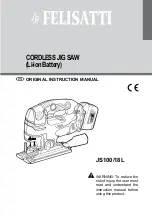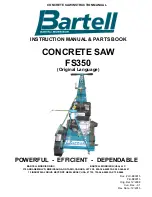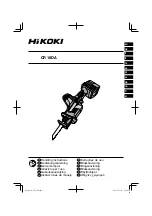
14
GB
- Use the stop rail (e).
-
Press the workpiece firmly against the cross stop (13).
- Switch on the saw.
- Push the cross stop (13) and the workpiece toward
the blade in order to make the cut.
-
Important:
Always hold the guided part of the workpiece.
Never hold the part which is to be cut off.
- Push the cross stop (13) forward until the workpiece is
cut all the way through.
- Switch off the saw again. Do not remove the offcut
until the blade has stopped rotating.
10.3 Cutting particle boards
To prevent the cutting edges from cracking when work-
ing with particle boards, you should not set the saw
blade (5) more than 5mm greater than the thickness of
the workpiece (also see 9.2).
11. Transport
1. Turn off the power tool before any transport and
disconnect it from the power supply.
2. Apply the power tool at least with two people, do
not touch the table extensions.
Use only the transport handles (Figure 43/44)
punched into both sides of the housing for trans-
porting the equipment.
3. Protect the power tool from knocks, bumps and
strong vibrations, such as during transport in vehi-
cles.
4. Secure the power tool against overturning and slid-
ing.
5. Never use the safety devices for handling or trans-
porting purposes.
12. Maintenance
m
Warning!
Prior to any adjustment, maintenance or
service work disconnect the mains power plug!
12.1 General maintenance measures
•
Keep all safety devices, air vents and the motor hous-
ing free of dirt and dust as far as possible. Wipe the
equipment with a clean cloth or blow it down with com-
pressed air at low pressure.
•
We recommend that you clean the equipment imme-
diately after you use it.
•
Clean the equipment regularly with a damp cloth and
some soft soap. Do not use cleaning agents or sol-
vents; these may be aggressive to the plastic parts in
the equipment. Ensure that no water can get into the
interior of the equipment.
•
In order to extend the service life of the tool, oil the
rotary parts once monthly. Do not oil the motor.
12.2 Brush inspection
In case of excessive sparking, have the carbon brushes
checked only by a qualified electrician. Important. The
carbon brushes should not be replaced by anyone but a
qualified electrician.
13. Storage
Store the device and its accessories in a dark, dry and
frost-proof place that is inaccessible to children. The
optimum storage temperature is between 5 and 30˚C.
Store the electrical tool in its original packaging.
Cover the electrical tool in order to protect it from dust
and moisture.
Store the operating manual with the electrical tool.
14. Electrical connection
The electrical motor installed is connected and
ready for operation. The connection complies with
the applicable VDE and DIN provisions.
The customer‘s mains connection as well as the
extension cable used must also comply with these
regulations.
•
The product meets the requirements of
EN 61000-3-11 and is subject to special connec-
tion conditions. This means that use of the product
at any freely selectable connection point is not al-
lowed.
•
Given unfavorable conditions in the power supply the
product can cause the voltage to fluctuate temporarily.
•
The product is exclusively intended for use at con-
nection points that have a continuous current-carry-
ing capacity of at least 100 Amper phase.
•
As the user, you are required to ensure, in consulta-
tion with your electric power company if necessary,
that the connection point at which you wish to ope-
rate the product meets the specified requirements.
Important information
In the event of an overloading the motor will switch
itself off. After a cool-down period (time varies) the mo-
tor can be switched back on again.
Damaged electrical connection cable
The insulation on electrical connection cables is often
damaged.
This may have the following causes:
•
Passage points, where connection cables are
passed through windows or doors.
•
Kinks where the connection cable has been improp-
erly fastened or routed.
•
Places where the connection cables have been cut
due to being driven over.
•
Insulation damage due to being ripped out of the
wall outlet.
•
Cracks due to the insulation ageing.
Such damaged electrical connection cables must not
be used and are life-threatening due to the insulation
damage.
Check the electrical connection cables for damage regu-
larly. Make sure that the connection cable does not hang
on the power network during the inspection.
Electrical connection cables must comply with the ap-
plicable VDE and DIN provisions. Only use connection
cables with the marking „H05VV-F“.
The printing of the type designation on the connection
cable is mandatory.
AC motor
•
The mains voltage must be 230 V~
•
Extension cables up to 25 m long must have a
cross-section of 1.5 mm
2
.
Connections and repairs of electrical equipment may
only be carried out by an electrician.
Please provide the following information in the event of
any enquiries:
Type of current for the motor
•
Machine data - type plate
•
Machine data - type plate
15. Disposal and recycling
The equipment is supplied in packaging to pre-
vent it from being damaged in transit. The raw
materials in this packaging can be reused or recy-
cled. Never place batteries in your household refuse, in
fire or in water. Batteries should be collected, recycled or
disposed of by environment-friendly means. The equip-
















































